Inveruglas Isle was visited by our archaeologists and tree surgeon in March 2025 and May 2025 to assess the potential benefit/impact to the castle of each cut prescribed in the HES report. Modifications to the plans were made in collaboration with Historic Environment Scotland. The work is planned in two stages with cutting planned for September 2025 and Fall 2026. The planned cutting will leave the natural screen of trees around the castle. The castle should not be significantly more exposed or visible from the shore as a result of the preservation work.
Detailed cutting plans document the approach and impact for each specified cut. The cutting plan is summarized in the following sections. Note the the detailed plan refers to each tree by Letter, consistent with the updated HES plan. The comments below also refer to Numbers as labels where the 3D model is being used for visual reference.
Detailed cutting plans document the approach and impact for each specified cut. The cutting plan is summarized in the following sections. Note the the detailed plan refers to each tree by Letter, consistent with the updated HES plan. The comments below also refer to Numbers as labels where the 3D model is being used for visual reference.
Remove Dead Trees on the West Wall of the CastleTree surgeons will climb and use trapeze's as necessary to sectionally cut and lower the large dead tree leaning from the outside on the west wall of the castle (1). It will be cut and removed from the site. The Ash growing near the boulder (2) will be used for support during cutting, then removed. It will be used to sectionally cut the large dead tree projecting out over the west wall (9). That tree (9) will the be removed.
|
Remove Trees from the Central Area of the CastleRemove trees from the central area of the castle including the large dead tree (9).
It was concluded that these trees did not have roots that penetrated the walls significantly and these trees could be removed completely. Where roots are now holding portions of wall together, HES recommends coppicing to reduce weight on the wall but to keep the tree alive. |
Manage Trees in the East WallCoppice Ash Tree V1 at 2 meters to keep alive but reduce root growth.
Coppice Rowan Tree V2 at 2 meters to keep alive but reduce root growth. These trees have roots heavily entangled in the eastern wall structure. Note Tree U at the right of the image. |
Coppice/Reduce the Multi-Trunked Tree U Projecting off the East WallThe roots of the large multi-trunked tree on the east wall are heavily embedded in the wall. The weight of the tree and its roots are clearly causing the wall to bulge. We need to try to keep the tree alive but we need to reduce weight, reduce wind profile and reduce overhang.
Coppice the largest trunk, possibly two trunks, at the base. Either leave the third trunk or coppice it at a height of 3 meters. This is illustrated using the model with Before (left) and After (right) in the image. |
Major Work: Remove the Central Ash R (7) from the Southwest TowerA full day is dedicated remove this tree (7 in the image) since it will have to be done slowly and carefully. The tree will be sectionally cut by a climbing tree surgeon with a second tree surgeon guiding cut pieces to the ground via trapeze. The trapeze will cross the tower wall, most likely to the east, and cut pieces will be small enough to be continuously controlled by two tree surgeons.
|
Manage the Remaining Trees in the Southwest Tower Walls - CoppicingThe roots of trees S2 and S3 (3 and 6 in the image) are deeply embedded in the wall fabric. Root growth will damage the walls, but dead roots will rot and destabilize the wall. These two trees should be reduced or coppiced and remain alive. Coppicing will cause the tree to focus on regenerating new growth rather than to expanding roots. The team, with HES, will decide specifics on the ground, but S2 (3) will likely be coppiced near base and S3 (6) at 2-3 meters for regrowth.
|








